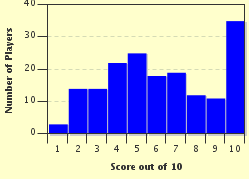Quiz Answer Key and Fun Facts
1. London had been known for its smoggy air long before the 'Great Smog' of 1952 which claimed many lives. Which two words are combined to make the word 'smog', and in what order?
2. From the early 1800s a new term was coined for the smog that plagued London. What was this descriptive expression?
3. Unfortunately, air pollution has been around for centuries. So badly affected was London in the early 14th century that King Edward I actually banned the use of domestic coal fires in the capital.
4. London's 'Great Smog' of 1952 was the UK's worst case of air pollution, with approximately 4,000 people dying from its effects during the five days it brought the city to a standstill, with many more deaths to follow. During which month did this occur?
5. In the few weeks prior to the 'Great Smog' of 1952 the weather conditions in London had not been as expected for the time of year. How had it varied?
6. Although all of London suffered from the effects of the 'Great Smog' of 1952, which area of London was the most badly affected?
7. People in London were used to the frequent smogs that befell the city, so at first there was not too much alarm at the arrival of the 'Great Smog' in 1952. The first sign that this smog was out of the ordinary was noted not among the human population but amongst which group of animals?
8. The 'Great Smog' of 1952 gave rise to London's nickname, a nickname that is also shared with other big industrialised cities around the world. What is this nickname?
9. Shortly prior to the 'Great Smog' of 1952 which significant event earlier in the year had contributed to higher levels of pollution in London due to increased emissions from motor vehicles?
10. In 1956 the British Government brought in an Act of Parliament to establish smokeless areas in London. What was the name of this Act?
Source: Author
Jennifer5
This quiz was reviewed by FunTrivia editor
gtho4 before going online.
Any errors found in FunTrivia content are routinely corrected through our feedback system.

